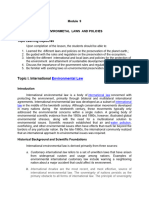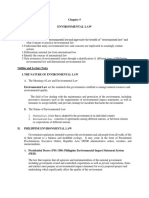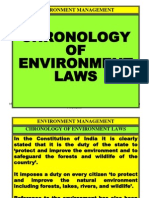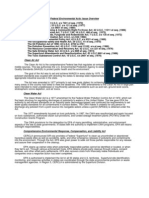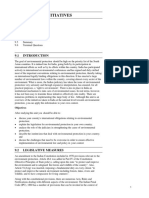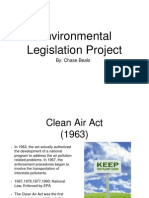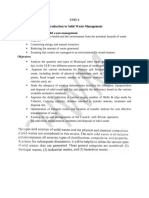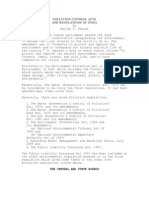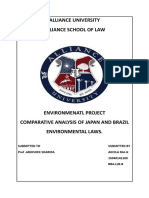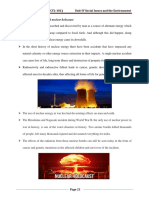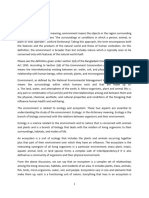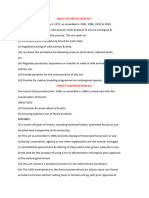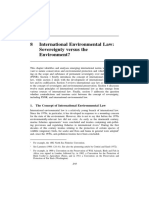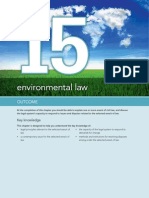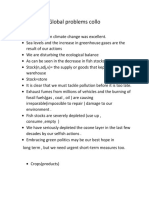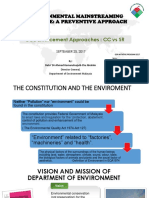0 ratings0% found this document useful (0 votes)
31 viewsInternational Treaties
International Treaties
Uploaded by
coolThe document lists and briefly describes major U.S. environmental laws and international treaties pertaining to the environment. Some of the key U.S. laws mentioned include the Clean Air Act, Clean Water Act, Endangered Species Act, and National Environmental Policy Act. International treaties discussed include the Kyoto Protocol, Montreal Protocol, and United Nations Framework Convention on Climate Change. The document provides a high-level overview of many of the major pieces of environmental legislation and agreements in the United States and globally.
Copyright:
© All Rights Reserved
Available Formats
Download as PDF, TXT or read online from Scribd
International Treaties
International Treaties
Uploaded by
cool0 ratings0% found this document useful (0 votes)
31 views5 pagesThe document lists and briefly describes major U.S. environmental laws and international treaties pertaining to the environment. Some of the key U.S. laws mentioned include the Clean Air Act, Clean Water Act, Endangered Species Act, and National Environmental Policy Act. International treaties discussed include the Kyoto Protocol, Montreal Protocol, and United Nations Framework Convention on Climate Change. The document provides a high-level overview of many of the major pieces of environmental legislation and agreements in the United States and globally.
Original Title
International treaties
Copyright
© © All Rights Reserved
Available Formats
PDF, TXT or read online from Scribd
Share this document
Did you find this document useful?
Is this content inappropriate?
The document lists and briefly describes major U.S. environmental laws and international treaties pertaining to the environment. Some of the key U.S. laws mentioned include the Clean Air Act, Clean Water Act, Endangered Species Act, and National Environmental Policy Act. International treaties discussed include the Kyoto Protocol, Montreal Protocol, and United Nations Framework Convention on Climate Change. The document provides a high-level overview of many of the major pieces of environmental legislation and agreements in the United States and globally.
Copyright:
© All Rights Reserved
Available Formats
Download as PDF, TXT or read online from Scribd
Download as pdf or txt
0 ratings0% found this document useful (0 votes)
31 views5 pagesInternational Treaties
International Treaties
Uploaded by
coolThe document lists and briefly describes major U.S. environmental laws and international treaties pertaining to the environment. Some of the key U.S. laws mentioned include the Clean Air Act, Clean Water Act, Endangered Species Act, and National Environmental Policy Act. International treaties discussed include the Kyoto Protocol, Montreal Protocol, and United Nations Framework Convention on Climate Change. The document provides a high-level overview of many of the major pieces of environmental legislation and agreements in the United States and globally.
Copyright:
© All Rights Reserved
Available Formats
Download as PDF, TXT or read online from Scribd
Download as pdf or txt
You are on page 1of 5
ENVIRONMENTAL LAWS & TREATIES
U.S. ENVIRONMENTAL LAWS
A list of major U.S. federal laws (unless otherwise indicated)
pertaining to the environment.
Atomic Energy Act (1954): Was passed because of the
government's keen interest in monitoring the commercial
and national defense uses of atomic energy. Government
concerns included radiation hazards and the disposal of
radioactive waste. The act establishes a general regulatory
structure for construction and use of nuclear power plants
and nuclear weapons facilities. Unlike most environmental
statutes, it does not permit citizen suits and affords only
limited opportunities for suits by public interest groups.
Clean Air Act (1970): Sets goals and standards for the
quality and purity of air in the United States. By law, it is
periodically reviewed. A significant set of amendments in
1990 toughened air quality standards and placed new
emphasis on market forces to control air pollution.
Clean Water Act (1972): Establishes and maintains goals
and standards for U.S. water quality and purity. It has been
amended several times, most prominently in 1987 to
increase controls on toxic pollutants, and in 1990, to more
effectively address the hazard of oil spills.
Coastal Zone Management Act (1972): Provides a
partnership structure allowing states and the federal
government to work together for the protection of U.S.
coastal zones from environmentally harmful
overdevelopment. The program provides federal funding to
participating coastal states and territories for the
implementation of measures that conserve coastal areas.
Michael Jasny
Comprehensive Environmental Response,
Compensation and Liability Act (1980): Requires the
cleanup of sites contaminated with toxic waste. This law is
commonly refered to as "Superfund." In 1986 major
amendments were made in order to clarify the level of
cleanup required and degrees of liability. CERCLA is
retroactive, which means it can be used to hold liable those
responsible for disposal of hazardous wastes before the law
was enacted in 1980.
Emergency Planning and Community Right-to-
Know Act (1986): Requires companies to disclose
information about toxic chemicals they release into the air
and water and dispose of on land.
Endangered Species Act (1973): Is designed to protect
and recover endangered and threatened species of fish,
wildlife and plants in the United States and beyond. The law
works in part by protecting species habitats.
Federal Food, Drug, and Cosmetic Act (1938): Is the
nation's major law regulating contaminants in food,
including pesticides. The Food and Drug Administration
implements most of this law; the Environmental Protection
Agency carries out its pesticide standard setting provisions
(with FDA enforcement). See also Food Quality Protection
Act.
Federal Land Policy and Management Act (1976):
Provides for protection of the scenic, scientific, historic and
ecologic values of federal lands and for public involvement
in their management.
Federal Insecticide, Fungicide, and Rodenticide Act
(1947): Controls the sale, distribution and application of
pesticides; amended in 1972, 1988, and 1996. See also Food
Quality Protection Act.
Food Quality Protection Act (1996): Is designed to
ensure that levels of pesticide residues in food meet strict
standards for public health protection. Under this law,
which overhauled the Federal Food, Drug, and Cosmetic Act
and the Federal Insecticide, Fungicide, and Rodenticide Act,
the Environmental Protection Agency is required to better
protect infants and children from pesticides in food and
water and from indoor exposure to pesticides.
Fisheries Conservation and Management Act (1976):
Governs the management and control of U.S. marine fish
populations, and is intended to maintain and restore healthy
levels of fish stocks and prevent overharvesting. Better
known as the Magnuson Stevens Act.
Marine Mammal Protection Act (1972): Seeks to
protect whales, dolphins, sea lions, seals, manatees and
other species of marine mammals, many of which remain
threatened or endangered. The law requires wildlife
agencies to review any activity -- for example, the use of
underwater explosives or high-intensity active sonar -- that
has the potential to "harass" or kill these animals in the wild.
The law is our nation's leading instrument for the
conservation of these species, and is an international model
for such laws. reviewed: Michael Jasny
National Environmental Policy Act (1970): Was the
first of the modern environmental statutes. NEPA created
environmental policies and goals for the country, and
established the President's Council on Environmental
Quality. Its most important feature is its requirement that
federal agencies conduct thorough assessments of the
environmental impacts of all major activities undertaken or
funded by the federal government. Many states have enacted
similar laws governing state activities.
Oil Pollution Act (1990): Enacted a year after the
disastrous Exxon Valdez oil spill in Alaska's Prince William
Sound, this law streamlines federal response to oil spills by
requiring oil storage facilities and vessels to prepare spill-
response plans and provide for their rapid implementation.
The law also increases polluters' liability for cleanup costs
and damage to natural resources and imposes measures --
including a phaseout of single-hulled tankers -- designed to
improve tanker safety and prevent spills.
Proposition 65 (1986): Is a California law passed by voter
initiative. Known as the Safe Drinking Water and Toxic
Enforcement Act, Prop. 65 is designed to provide public
warnings about the risk of exposure to toxic chemicals and
to eliminate toxins from drinking water supplies. It is
responsible for California having some of the strongest
environmental protections in the nation, and thus has
helped make the state a model for other regions seeking to
address environmental hazards.
Resource Conservation and Recovery Act (1976):
Seeks to prevent the creation of toxic waste dumps by
setting standards for the management of hazardous waste.
Like CERCLA, this law also includes some provisions for
cleanup of existing contaminated sites.
Safe Drinking Water Act (1974): Establishes drinking
water standards for tap water safety, and requires rules for
groundwater protection from underground injection;
amended in 1986 and 1996. The 1996 amendments added a
fund to pay for water system upgrades, revised standard:
setting requirements, required new standards for common
contaminants, and included public "right to know"
requirements to inform consumers about their tap water.
Surface Mining Control and Reclamation Act (1977):
Is intended to ensure that coal mining activity is conducted
with sufficient protections of the public and the
environment, and provides for the restoration of abandoned
mining areas to beneficial use. Johanna Wald
Toxic Substances Control Act (1976): Authorizes the
Environmental Protection Agency to regulate the
manufacture, distribution, import and processing of certain
toxic chemicals.
INTERNATIONAL TREATIES
A short list of international treaties pertaining to the
environment.
Comprehensive Test Ban Treaty: A proposed treaty to
prohibit all testing of nuclear weapons in all environments:
underground, underwater, in the atmosphere and in space.
In 1999, the U.S. Senate refused to ratify the treaty.
The Kyoto Protocol: An international agreement setting
binding limits on emissions of greenhouse gases from
industrialized countries. This agreement was adopted in
Kyoto Japan in December 1997 and supplements the United
Nations Framework Convention on Climate Change adopted
in 1992.
Montreal Protocol: International agreement signed by
more than 150 countries to limit the production of
substances harmful to the stratospheric ozone layer, such as
CFCs.
Non-Proliferation Treaty: A multilateral treaty signed in
1968 which aims to control the spread of nuclear weapons;
extended indefinitely in May 1995. The treaty has been
signed by over 175 nations.
United Nations Framework Convention on Climate
Change: An international agreement for dealing with
climate change, adopted at the United Nations Conference
on Environment and Development (the "Earth Summit") in
Rio in 1992. AKA Climate Change Convention; Climate
Treaty. (See also Kyoto Protocol.)
For more detailed and comprehensive information, visit
Environmental Treaties and Resource Indicators (ENTRI), a
searchable database of international environmental treaties
from the Center for International Earth Science Information
Network (CIESIN).
You might also like
- LLB Environmental Law NotesDocument56 pagesLLB Environmental Law NotesNathan Nakibinge71% (7)
- Toilet Facilities (Philippines Setting)Document5 pagesToilet Facilities (Philippines Setting)Nasripha Malawani0% (1)
- Environmental Laws & Regulations: University of California College Prep University of CaliforniaDocument4 pagesEnvironmental Laws & Regulations: University of California College Prep University of CaliforniaErrol Luke Palomo PaclibarNo ratings yet
- Laws and Treaties Applicable To APESDocument6 pagesLaws and Treaties Applicable To APESApril TurnerNo ratings yet
- PEE Module 10Document10 pagesPEE Module 10cristelmendoza1205No ratings yet
- Lesson On Environmental LawDocument3 pagesLesson On Environmental LawAllan Miguel SantuyoNo ratings yet
- Env LegislationDocument6 pagesEnv LegislationjoshivishwanathNo ratings yet
- Chronology of Environment LawsDocument11 pagesChronology of Environment LawsRachit GhardeNo ratings yet
- Environmental LegislationDocument22 pagesEnvironmental LegislationSankha Subhra NathNo ratings yet
- EnvironmentDocument13 pagesEnvironment20bba045No ratings yet
- Environment Legislation Unit-4Document12 pagesEnvironment Legislation Unit-4narwalmanish826No ratings yet
- Environmental Laws and PoliciesDocument47 pagesEnvironmental Laws and Policiesangelo luceroNo ratings yet
- International Environmental Law LectureDocument20 pagesInternational Environmental Law LectureAbdul Moiz KhanNo ratings yet
- Federal Environmental Acts: Issue OverviewDocument4 pagesFederal Environmental Acts: Issue OverviewAbdul AlimNo ratings yet
- Unit 9 State Initiatives: StructureDocument12 pagesUnit 9 State Initiatives: StructureSaahil BawaNo ratings yet
- Comparative Public Law ArticleDocument8 pagesComparative Public Law ArticleBlahNo ratings yet
- Envi LawsDocument3 pagesEnvi Lawsgt201903264No ratings yet
- Environmental Legislation Project: By: Chase BealsDocument6 pagesEnvironmental Legislation Project: By: Chase BealsChaseBealsNo ratings yet
- Natural Resources - Environmental QualityDocument4 pagesNatural Resources - Environmental QualityBernice GonzalezNo ratings yet
- What Is The Purpose of Environmental LawDocument8 pagesWhat Is The Purpose of Environmental LawZainal Akmal Ahmad ShukkeriNo ratings yet
- Introduction To Solid Waste Management: Unit-IDocument11 pagesIntroduction To Solid Waste Management: Unit-IMohan KonathalaNo ratings yet
- Pollution Control Acts and Regulations of India For Chloro Alkali Industry by S. AliDocument14 pagesPollution Control Acts and Regulations of India For Chloro Alkali Industry by S. AliPikuramNo ratings yet
- Presn On Env. Mangmt and LegislationDocument66 pagesPresn On Env. Mangmt and Legislationrajbaba04No ratings yet
- Environmental Law NotesDocument37 pagesEnvironmental Law NotesAkhil SomanNo ratings yet
- Notes of Unit-6 ES115Document7 pagesNotes of Unit-6 ES115siddfarah6387No ratings yet
- Environmental Law (1078-1103)Document27 pagesEnvironmental Law (1078-1103)rchnmnvNo ratings yet
- Major Indian Environmental LawsDocument4 pagesMajor Indian Environmental LawsShubhangi MeshramNo ratings yet
- Enivornment Law Final ProjectDocument24 pagesEnivornment Law Final ProjectakhilaNo ratings yet
- Environmental Law NotesDocument50 pagesEnvironmental Law Notespoiuytrewq9115100% (1)
- Unit 23 Environmental Legislation: ObjectivesDocument11 pagesUnit 23 Environmental Legislation: Objectivestarakesh17No ratings yet
- Jogesh Chandra Chaudhuri College: Environmental Studies Project WorkDocument17 pagesJogesh Chandra Chaudhuri College: Environmental Studies Project WorkVILGAX GAMINGNo ratings yet
- Factors That Hinder The Implementation of Global Environmental LawsDocument13 pagesFactors That Hinder The Implementation of Global Environmental LawsAlNo ratings yet
- Lecture 4Document8 pagesLecture 4Sam DrakesNo ratings yet
- Research PaperDocument9 pagesResearch PaperTanu RathiNo ratings yet
- T E E R V I S: P, L, I F: Mulugeta GetuDocument30 pagesT E E R V I S: P, L, I F: Mulugeta GetuJust BelieveNo ratings yet
- Air, Water & Forest Acts - Tutorialspoint PDFDocument2 pagesAir, Water & Forest Acts - Tutorialspoint PDFdesamuduru19No ratings yet
- Environmental Laws in IndiaDocument8 pagesEnvironmental Laws in IndiavtayadeNo ratings yet
- HVES Unit 4Document19 pagesHVES Unit 4akky.vns2004No ratings yet
- Environment Protection ActDocument31 pagesEnvironment Protection ActVIKASH RATHINAVEL K R XII BNo ratings yet
- Environmental Law AssignmentDocument5 pagesEnvironmental Law AssignmentAakanksh GuptaNo ratings yet
- Appendix 1 PDFDocument4 pagesAppendix 1 PDFsandeep shahaNo ratings yet
- CDI 9 ENVIRONMENTAL LAW Its TYPE AND PRINCIPLEsDocument27 pagesCDI 9 ENVIRONMENTAL LAW Its TYPE AND PRINCIPLEsFritzy Gwen Baba100% (2)
- Unit 5 NotesDocument20 pagesUnit 5 Notesomanshbe23ce010No ratings yet
- BSECE 4A Environmental Laws ReportDocument9 pagesBSECE 4A Environmental Laws ReportCatherine BalanoNo ratings yet
- Assignment - 4 Human Rights: Great Indian Bustard (GIB)Document5 pagesAssignment - 4 Human Rights: Great Indian Bustard (GIB)Gowsik RameshNo ratings yet
- Social Studies - DebateDocument5 pagesSocial Studies - Debate102133No ratings yet
- Environment Protection Act 1986Document10 pagesEnvironment Protection Act 1986Career Will100% (1)
- Lecture 1 Introduction To Environment and LawDocument10 pagesLecture 1 Introduction To Environment and Lawsayem talukderNo ratings yet
- Environmental Legislation RegulationsDocument16 pagesEnvironmental Legislation RegulationsrajapratyNo ratings yet
- Handout5 Env Science 2020 PDFDocument6 pagesHandout5 Env Science 2020 PDFStevenzel Eala EstellaNo ratings yet
- Framework of Environmental Regulations 2nd VersionDocument82 pagesFramework of Environmental Regulations 2nd VersionDelmer Riparip100% (1)
- Environmental Law: Environmental Law, Principles, Policies, Directives, and Regulations Enacted and Enforced byDocument9 pagesEnvironmental Law: Environmental Law, Principles, Policies, Directives, and Regulations Enacted and Enforced byBiogenicNo ratings yet
- Pdf&rendition 1 1Document13 pagesPdf&rendition 1 1rakshajain287No ratings yet
- Environmental Law NotesDocument72 pagesEnvironmental Law NotesNenz Farouk100% (1)
- International and Environmental Law Sovereignty Versus The EnvironmentDocument20 pagesInternational and Environmental Law Sovereignty Versus The EnvironmentAnna Lídia Di NápoliNo ratings yet
- Jep 33 4 27Document26 pagesJep 33 4 27David NoriegaNo ratings yet
- Environmental Law: OutcomeDocument38 pagesEnvironmental Law: OutcomeZulaika KassimNo ratings yet
- Name - Tanay Dubey Registration Number - 19BCT0185 CHY1002 - Environmental Sciences Digital Assingment - IIDocument9 pagesName - Tanay Dubey Registration Number - 19BCT0185 CHY1002 - Environmental Sciences Digital Assingment - IITANAY DUBEY 19BCT0185No ratings yet
- Annotated Rules On Environmental CasesDocument22 pagesAnnotated Rules On Environmental CasesJoie Tarroza-Labuguen100% (1)
- Legal ProvisionsDocument18 pagesLegal ProvisionsNauraa JeenaNo ratings yet
- Weather Warfare: Unleashing Nature's Fury, Strategic Manipulation in Modern ConflictFrom EverandWeather Warfare: Unleashing Nature's Fury, Strategic Manipulation in Modern ConflictNo ratings yet
- China's Crusade Against Its Tech FirmsDocument5 pagesChina's Crusade Against Its Tech FirmscoolNo ratings yet
- The Impact of The US Federal Policy On IndiaDocument5 pagesThe Impact of The US Federal Policy On IndiacoolNo ratings yet
- New Face of India's VC WorldDocument6 pagesNew Face of India's VC WorldcoolNo ratings yet
- Burget Paints Financial Report Summary and InsightsDocument5 pagesBurget Paints Financial Report Summary and InsightscoolNo ratings yet
- Architects PuneDocument6 pagesArchitects Punecool0% (2)
- Institute ID: IR-3-A-OEA-U-0189 (ARCHITECTURE) Institute Name: National Institute of Technology Hamirpur, HamirpurDocument2 pagesInstitute ID: IR-3-A-OEA-U-0189 (ARCHITECTURE) Institute Name: National Institute of Technology Hamirpur, HamirpurcoolNo ratings yet
- Klyde Warren Park, Dallas, TX: Urban Design Literature Study by Suren Mahant 10008Document24 pagesKlyde Warren Park, Dallas, TX: Urban Design Literature Study by Suren Mahant 10008coolNo ratings yet
- IndianhabitatcenterDocument29 pagesIndianhabitatcentercool0% (1)
- Guidelines ASI Museums 14Document19 pagesGuidelines ASI Museums 14coolNo ratings yet
- Apresentação InglesDocument2 pagesApresentação Inglesdiogo pereiraNo ratings yet
- Hayati BreveragesDocument5 pagesHayati BreveragessalesNo ratings yet
- M C Mehta Vs Union of IndiaDocument9 pagesM C Mehta Vs Union of IndiapriyanshuNo ratings yet
- Environmental HealthDocument4 pagesEnvironmental HealthXris Loidz GanadoNo ratings yet
- YES O Action PlanDocument2 pagesYES O Action PlanEVANGELINE CANTERO100% (1)
- Environmental & Social Monitoring PlanDocument49 pagesEnvironmental & Social Monitoring Planmoses kyambade100% (1)
- CSE407 PROJECT REPORT Group-10FINALDocument17 pagesCSE407 PROJECT REPORT Group-10FINALIffat Jahan ShornaNo ratings yet
- BN Noisepollution Advanced Worksheet 6384Document7 pagesBN Noisepollution Advanced Worksheet 6384Erika HanulaNo ratings yet
- Haze in Malaysia 2019Document21 pagesHaze in Malaysia 2019farah6214No ratings yet
- Application Form For Permit To Operate (PTO) Air Pollution Source InstallationsDocument3 pagesApplication Form For Permit To Operate (PTO) Air Pollution Source InstallationsRob ClosasNo ratings yet
- Global Problems CollocationsDocument3 pagesGlobal Problems Collocationsnoosha kamaliNo ratings yet
- Water Pollution Review of LiteratureDocument8 pagesWater Pollution Review of Literatureea5vpya3100% (1)
- Final Report API (Group 6)Document13 pagesFinal Report API (Group 6)syea amin aliNo ratings yet
- Garbage - Reading Comprehension & Summary 2022 Sem2 PracticeDocument6 pagesGarbage - Reading Comprehension & Summary 2022 Sem2 PracticeHtet Oo NaungNo ratings yet
- China National Chemical Engineering No. 14 Construction Co., LTD PDFDocument62 pagesChina National Chemical Engineering No. 14 Construction Co., LTD PDFousoulegrandNo ratings yet
- Biodegradable and Non Bio-Degradable SubstancesDocument12 pagesBiodegradable and Non Bio-Degradable SubstancessdfkjklsdfNo ratings yet
- Group 4 Environmental PollutionDocument21 pagesGroup 4 Environmental PollutionSo NeangNo ratings yet
- M.C.Mehta V. Union of India: (AIR 1987 SC 1086)Document16 pagesM.C.Mehta V. Union of India: (AIR 1987 SC 1086)Saurabh BaraNo ratings yet
- HazCom 4Document27 pagesHazCom 4Syafiq KhalilNo ratings yet
- BED - IPAL Cap 50 CMPD - PT Balikpapan Enviromental ServicesDocument3 pagesBED - IPAL Cap 50 CMPD - PT Balikpapan Enviromental ServicesSalman RatoNo ratings yet
- Environmental Conservation in JainismDocument8 pagesEnvironmental Conservation in Jainismpoojasharma000No ratings yet
- Environmental Mainstreaming Directive CompressedDocument22 pagesEnvironmental Mainstreaming Directive Compressedda_reaper_dasNo ratings yet
- Microproject Part-A: Analysis of Waste Management in IndustryDocument16 pagesMicroproject Part-A: Analysis of Waste Management in Industrybhagyashrimunde86No ratings yet
- Evaluation of Municipal Solid Waste Management in B/DAR CityDocument56 pagesEvaluation of Municipal Solid Waste Management in B/DAR Citytazebew txNo ratings yet
- Apar Silvassa LubesDocument8 pagesApar Silvassa LubesROOPDIP MUKHOPADHYAYNo ratings yet
- Grade 2 English U 6 and 7Document26 pagesGrade 2 English U 6 and 7Lidya AberaNo ratings yet
- Environmental PollutionDocument2 pagesEnvironmental PollutionJohn DapzarNo ratings yet
- Sample Barangay Environmental Management PlanDocument4 pagesSample Barangay Environmental Management PlanMa. Concepcion CalderonNo ratings yet
- Assignment #2 Ecosystem in Your Community: Mapúa UniversityDocument8 pagesAssignment #2 Ecosystem in Your Community: Mapúa UniversityQuirino Arzadon IVNo ratings yet




